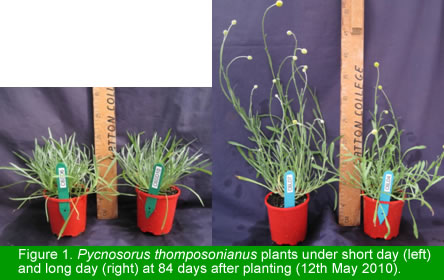
Summary of final report on the Australian Flora Foundation funded project:
Dr Margaret Johnston
Land Crop and Food Sciences, The University of Queensland Gatton
December 2010
Asteraceae species have been the focus of much of the Australian research on flowering physiology. Information on the flowering responses of several species has been published (Mott and McComb 1975; Sharman and Sedgley 1988; 1989 a, b; Sharman et al. 1990; Bunker 1995). Species have been classified into facultative long day plants (LDP), facultative short day plants (SDP) and day neutral species. For some species the importance of low temperatures for flowering has been reported (Mott and McComb 1975; Sharman and Sedgley (1988; 1989a, b; Sharman et al. 1990). Flowering of Rhodanthe chlorocephala subsp. rosea (syn. Helipterum roseum) was inhibited at constant 25°C under a 12 h photoperiod at 250 Wm-2 (Sharman and Sedgley 1989b: Sharman et al 1990). Halevy et al. (2001) reported that temperature influenced the daylength response of the woody cut flower species Ozothamnus diosmifolius (syn. Helichrysum diosmifolium) in Israel.
Many studies have reported a range of diverse flowering responses of Australian species to temperature, daylength and light intensity including Acacia (Sedgley 1985), Chamelaucium (Shillo et al 1984; Dawson and King 1993), Anigozanthos (Motum and Goodwin 1987), Eucalyptus (Moncur 1992), Pimelea (King et al. 1992; King et al. 1995; Seaton and Plummer 2004), Boronia and Hypocalymma (Day et al. 1994), Hardenbergia (King 1998), Crowea, Lechenaultia and Verticordia (King et al. 2008), Brunonia and Calandrinia (Cave et al 2010a and b; Wahyuni et al. 2011 in press).
The diversity of flowering responses reported means that each species requires investigation of the effect of environmental factors on flowering to enable manipulation of flowering time especially if species are to be used as potted colour products. In addition it is important to understand juvenility and determine when the seedling is able to perceive the flowering signal as well as quantifying the effect of environmental factors on flower induction, initiation and development. Environmental factors also influence plant habit particularly height and branching and this can influence the number of flowers per plant and hence plant quality. Plant growth regulators can be used to modify plant habit and may also influence flowering (King et al. 2008).
This study investigated the flowering responses of Brunonia australis, Calandrinia sp. (Mt Clere; not yet fully classified), Pycnosorus thompsonianus and Rhodanthe floribunda.
The first study on Brunonia australis R. Br (Goodeniaceae) and Calandrinia (Portulacaceae) investigated the role of daylength and growth regulators, Gibberellic acid (GA3) and paclobutrazol (Pac), to control vegetative growth, peduncle elongation and flowering of Brunonia and Calandrinia. Plants were grown under long days (16h), short days (11h) and 8 weeks under short day then transferred to long day (SDLDs). Plants in each daylength were treated with GA3, Pac, and GA3+ Pac. GA3 was applied as 10 µL drop of 500 mg L-1 concentration to the newest mature leaf. A single application of Pac was applied as a soil drench at 0.25 mg a.i. dose per plant.
Both Brunonia and Calandrinia flowered earlier in long days but still flowered in short days, so both can be classified as facultative LD plants. Brunonia under SDLDs were more vigorous and attractive than plants under LDs while still being more compact than plants under SDs. In Brunonia, GA3 promoted earlier flowering and increased the number of inflorescences under SDs. Pac at 0.25 mg a.i. per plant applied alone or in combination with GA3 delayed flower development in Brunonia, and resulted in a reduced number of inflorescences per plant compared to the control plants. Vegetative growth of Calandrinia was similar under LDs, SDs and SDLDs, whereas GA3 application increased plant size. Pac-treated Calandrinia looked compact and attractive, and Pac application did not affect time to flower and flower number.
The second study investigated the flowering responses of Pycnosorus thompsonianus (Asteraceae), to daylength and temperature regimes. Plants were cooled at 20/10°C or kept at 30/20°C for 21 or 42 days under short day (SD), long day (LD), or short day for six weeks before transfer to long day (SDLD).
LDs promoted earlier flowering and plants under LDs flowered regardless of temperature regimes. Cool temperatures and cooling periods were required for flowering of plants under SDs, but this was not important for plants under LDs and SDLDs. Plants under SDs without cooling only produced 3 inflorescences per plant whereas plants which received 21 or 42 days of cooling had 19. Forty-two percent of the SD plants under 30/20°C remained vegetative after a 20 week growing period. Extending the cooling period from 21 to 42 days induced earlier flowering of plants in all daylengths but did not increase number of inflorescences per plant. Daylength was more effective than temperatures for promoting earlier flowering and for increasing the flower production (Fig 1).
Similar to Pycnosorus, plants of R. floribunda flowered without chilling showing a facultative requirement for low temperature. Plants were competent to perceive chilling as one day old seedlings. Chilling for 21 days was the most effective treatment, reducing time to first visible floral bud (FVFB) and anthesis and increasing inflorescence number by 100% at 23 weeks. Chilling for seedlings at 4 week old stage increase flowering of by 4-5-fold.
The number of growing degree days (GDD) from transplanting to FVFB and anthesis of 3 week chilled plants of R. floribunda was found to be shortest among chilling treatments with 419 and 628 degree days, respectively. These could be used to guide for commercial production to reduce production time by chilling plants at seedling stage (4 weeks old) for 3 weeks under 20/100C.
